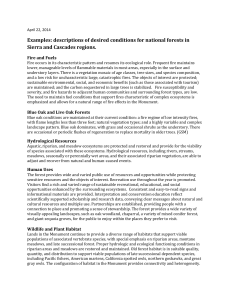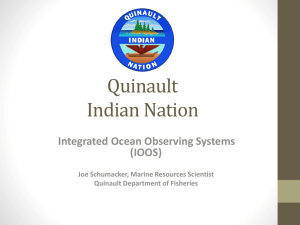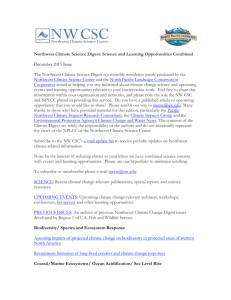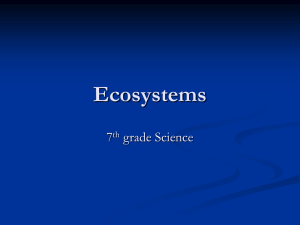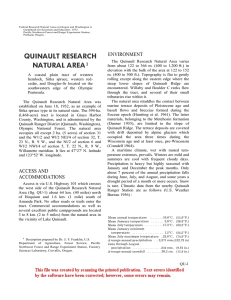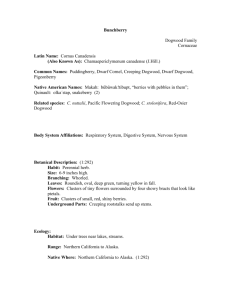Climate Change and the Quinault Indian nation
advertisement
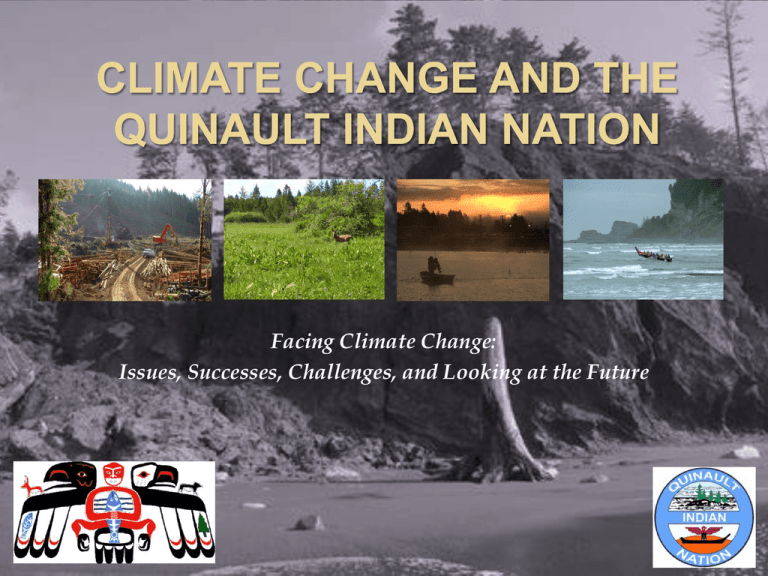
Facing Climate Change: Issues, Successes, Challenges, and Looking at the Future Climate change exacts disproportionate social, economic, and cultural impacts on tribes limited by scarce resources, mobility, and access to information. These inequities are amplified as rates of change accelerate (Bull Bennett and Maynard 2013). Climate Change and Indian Forestry (Indian Forest Management Team) # Q uee ts Q U IN AU L T IN D IA N R E S E R V A TIO N ST R A I T OF JU A N DE F U CA Q U IN # # F or k s T aho la h U S 10 1 # EA N IC O C PACIF ER T R IV AU L # # A b er d ee n S e attle O ly m pia I-5 W N I H AS N O GT LA QU KE IN A UL T Multifarious value of Natural Resources: i.e. Cultural, Economic, Tradition, etc… …The many uses of Western Red Cedar… A “Nature-Culture Nexus” Tribal worldview – we are a part of nature not apart from nature “Reciprocity”…. a give and take relationship with Mother Earth …The physical, mental, social, and spiritual health of Quinault people is directly and uniquely related to the health of the ecosystems of the lands they inhabit… Healthy Ecosystems → Healthy Resources → Healthy People Ocean Acidification Sea Level Rise Invasive species/disease Increased wildfire seasons Increased severity of storms Melting glaciers Severe drought Increased rainfall Anderson Glacier Historically a source of cool, clean water during warm summer months Benefits Salmon at all life stages…especially diminishing Spring Chinook Compounded by anthropogenic ecosystem degradation in Quinault Watershed… …Illustrates the need to protect & restore degraded ecosystem function, in order to increase resilience to climate change impacts… 1850 Abundant Functional Salmon Habitat (Taiya River, Alaska) Today Limited Functional Salmon Habitat (Quinault River, Washington) …Forests are both a result of, and a contributing factor to climate… …with climate change implications comes new considerations for Northwest Forest Managers… Healthy Ecosystems Climate Change Healthy Ecosystems Changes in Seedling regeneration & Tree growth Potential increases in forest fires Invasive Species/Disease The PNW is likely to see increased forest growth region-wide over the next few decades followed by decreased forest growth as temperature increases overwhelm the ability of trees to make use of higher winter precipitation and higher carbon dioxide. Potential for extinction of local populations and loss of biological diversity if environmental shifts outpace species migration rates and interact negatively with population dynamics. Cultural Significance Traditional Hunting & Gathering Areas Abundant in Culturally Significant Flora & Fauna… Labrador tea, camas, bear grass, huckleberry, bracken fern, deer, elk, waterfowl, upland game birds, etc… Wide variety of uses of plant species…i.e. traditional food, medicine, & fibrous materials …The waves of change…climate change… •Increased coastal erosion and beach loss due to rising sea levels •Increased landslides due to increased winter rainfall •Increased coastal flooding due to sea level rise and increased winter stream flow from interior and coastal watersheds •Increased acidity has been shown to have serious impacts to calcification in some of our shell and plate forming plank tonic organisms; especially in coastal waters. •Sea Level Rise & Temperature Changes Increased awareness of climate change and related issues Increased efforts by various departments Greater involvement with other organizations/institutions/tribes/etc. Increased collaboration Ethnobotany & Ocean Acidification Projects - students Staff efforts providing a stronger voice for the our needs QDNR Climate Change Committee Multi-Tribe Vulnerability Assessment Grant Proposals for funding Travel to training/conferences Youth Initiatives; getting students involved in the natural resources and climate change Other Interests Getting youth involved (Tribal Lands Day) Move the Lower Village Purchase land to create a tsunami evacuation route Invasive Species - Genetic work with trees Habitat Loss - Engineered Log Jams Better Forestry Management (increase RMZ, increase species diversity, education of others) The Climate Change Committee is an interdepartmental collaboration of technical and upper level staff whose goal is to organize and coordinate a climate change initiative within the Division. The Committee will act as a source and clearing house for knowledge, news and innovations to address climate change issues and concerns related to natural resources management and protection within the Quinault Territory. The Committee will focus on researching and discussing potential climate effects to natural resources which are economically and culturally important to the Quinault Indian Nation. The QDNRCCC also seeks to find funding and resources for protecting these natural resources and mitigating for future effects. Staffing! Time, availability, etc. Funding! Vulnerability assessment, adaptation plans, generation of baseline data, implementation of mitigation efforts, etc. ‘Doing stuff’ General Coordination! Who’s doing what? Who’s applying for grants? 23 Potential contributions of Traditional Ecological Knowledge (TEK) in contemporary Natural Resource Management Continued efforts to combine experiential, intergenerational knowledge with experimental sciences Tribal communities are willing and able! For 1000’s of Years, we have gained traditional knowledge that has enabled us to adapt to changing climates and landscapes …Today, tribes and others must join together to help our communities prepare for and adapt to climate change… 25
